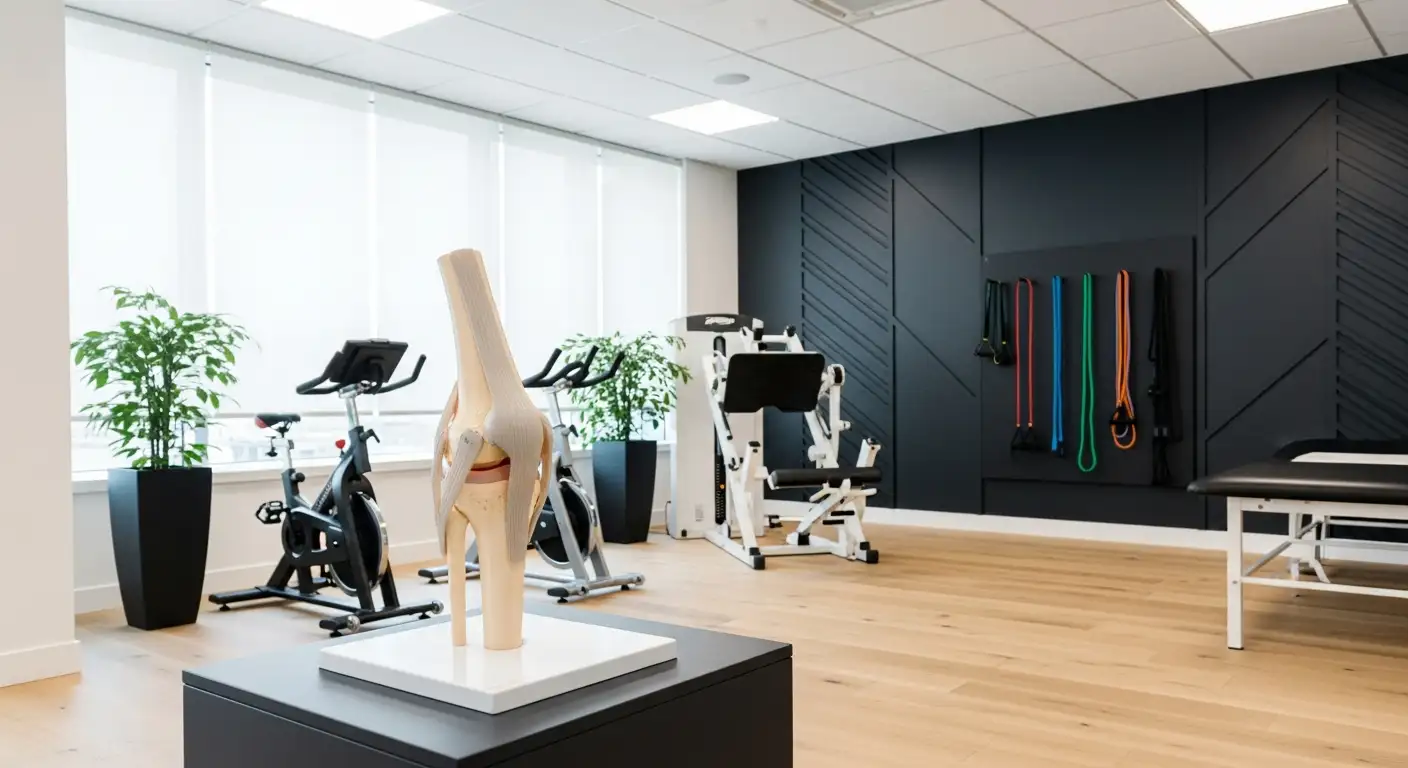Understanding Knee Pain while Walking
Knee pain while walking is a common symptom experienced by many individuals, especially older adults [1]. It can significantly impact daily activities and quality of life. Understanding the common causes of knee pain while walking and implementing short-term management techniques can help alleviate discomfort and improve mobility.

Common Causes of Knee Pain while Walking
The most common causes of knee pain while walking include:
Short-Term Management Techniques
In the short term, several techniques can help manage knee pain while walking:
Implementing these short-term management techniques can help alleviate immediate knee pain while walking. However, it's important to seek long-term solutions to address the underlying causes and prevent further discomfort.
In the next section, we will explore long-term solutions for managing knee pain while walking, including the benefits of physical therapy and surgical options.
Long-Term Solutions for Managing Knee Pain while Walking
When it comes to managing knee pain while walking, it's crucial to explore long-term solutions that address the root causes of the pain. Two effective strategies for long-term management are physical therapy and surgical options.
The Benefits of Physical Therapy
Physical therapy plays a significant role in managing knee pain while walking. It involves exercises and stretches that can help alleviate pain, improve mobility, and strengthen the muscles around the knee joint. Strengthening exercises for the quadriceps and hamstrings are particularly beneficial in providing support to the knee joint and reducing pain [1].
Regular physical therapy sessions can help improve muscle strength and flexibility, leading to better knee stability and reduced pain while walking. The exercises prescribed by a physical therapist are tailored to the individual's specific needs and may include leg lifts, squats, step-ups, and other targeted movements.
In addition to strengthening exercises, stretching exercises are also essential in managing knee pain while walking. These exercises improve flexibility, reduce stiffness, and promote better range of motion in the knee joint. By incorporating a combination of strengthening and stretching exercises into a regular physical therapy routine, individuals can experience long-term relief from knee pain while walking.
Surgical Options for Knee Pain
In some cases, when conservative treatments fail to provide sufficient relief, surgical options may be considered for managing knee pain while walking. Surgical interventions are typically reserved for severe cases and when there is significant damage to the knee joint.
The specific surgical procedure recommended depends on the underlying cause of the knee pain. Some common surgical options include arthroscopy, partial knee replacement, and total knee replacement. Arthroscopy is a minimally invasive procedure used to diagnose and treat various knee conditions. Partial knee replacement involves replacing only the damaged part of the knee joint, while total knee replacement replaces the entire knee joint with an artificial implant.
Surgery should always be discussed with a healthcare professional, who can assess the individual's condition and determine the most appropriate course of action. Rehabilitation and physical therapy are typically required after surgery to optimize recovery and restore normal function.
It's important to note that surgical options are generally considered a last resort when other conservative treatments have been exhausted. Each individual's situation is unique, and a thorough evaluation by a healthcare provider is necessary to determine the best course of action for managing knee pain while walking.
By exploring long-term solutions such as physical therapy and, if necessary, surgical options, individuals can find effective ways to manage knee pain while walking. These approaches aim to address the underlying causes of the pain and provide lasting relief, improving mobility and overall quality of life.
Exercise Strategies for Knee Pain Relief
When it comes to managing knee pain while walking, incorporating exercise into your routine can be highly beneficial. Exercise helps strengthen the muscles around the knee joint, improves flexibility, and reduces pain. In this section, we will explore two effective exercise strategies for knee pain relief: low-impact exercises for strengthening and stretching for flexibility.
Low-Impact Exercises for Strengthening
Low-impact exercises are an excellent option for individuals experiencing knee pain while walking. These exercises help strengthen the muscles around the knee joint without putting excessive strain on it. Some popular low-impact exercises include:
These exercises help improve overall leg strength, which provides better support to the knee joint. By incorporating low-impact exercises into your routine, you can manage knee pain while still engaging in physical activity.
Stretching for Flexibility
Stretching exercises are crucial for improving flexibility and reducing knee pain while walking. Stretching helps elongate the muscles and tendons around the knee joint, reducing tightness and pressure. One effective stretching exercise for knee pain relief is hamstring stretches. To perform this stretch:
Regularly incorporating hamstring stretches into your routine can help improve flexibility and alleviate knee pain while walking.
In addition to stretching, it's important to focus on strengthening exercises that target the muscles around the knee. Leg lifts, squats, and step-ups are effective exercises for strengthening the muscles supporting the knee joint [2]. Strengthening these muscles can help reduce knee pain and improve stability while walking.
Remember, it's essential to consult with a healthcare professional or physical therapist before starting any exercise program for knee pain relief. They can provide personalized guidance and recommend specific exercises based on your condition and individual needs. By incorporating low-impact exercises for strengthening and stretching into your routine, you can take proactive steps towards managing knee pain while walking.
Supporting Your Knees
When it comes to managing knee pain while walking, providing proper support to your knees is essential. This support can be achieved through two main approaches: wearing proper footwear and utilizing assistive devices.
The Importance of Proper Footwear
Wearing supportive and properly fitting shoes plays a crucial role in reducing knee pain while walking. The right footwear can provide cushioning and stability to the feet and knees, minimizing the impact on the joints during each step. It is recommended to opt for shoes with the following features:
It is advisable to consult with a podiatrist or footwear specialist to determine the most suitable shoe type for your specific needs. They can analyze your gait and foot structure to recommend the appropriate footwear that promotes proper alignment and reduces knee pain.
Assistive Devices for Walking
For individuals experiencing knee pain while walking, assistive devices can provide additional support and alleviate the load on the knees. Here are a few commonly used assistive devices:
When considering the use of assistive devices, it is advisable to consult with a healthcare professional, such as a physical therapist or orthopedic specialist. They can assess your specific needs and recommend the most suitable device to support your knees while walking.
By choosing proper footwear and utilizing assistive devices, you can provide the necessary support to your knees, reducing pain and discomfort while walking. Remember to seek professional guidance to ensure that you select the most appropriate options for your specific condition.
Additional Approaches for Managing Knee Pain while Walking
When it comes to managing knee pain while walking, there are additional approaches that can provide relief and improve overall comfort. Two key strategies to consider are medications for pain relief and weight management.
Medications for Pain Relief
For temporary relief from knee pain while walking, medications can be helpful. Nonsteroidal anti-inflammatory drugs (NSAIDs) such as ibuprofen and naproxen can help reduce inflammation and alleviate pain. These medications work by inhibiting the production of certain chemicals in the body that contribute to pain and inflammation. It's important to note that long-term use of NSAIDs should be discussed with a healthcare provider due to potential side effects.
MedicationPurposeRecommended DosageIbuprofenReduces pain and inflammation200-400mg every 4-6 hoursNaproxenRelieves pain and reduces inflammation220-550mg every 8-12 hours
It's crucial to follow the recommended dosage instructions and consult a healthcare professional before starting any medication regimen, especially if you have any underlying medical conditions or take other medications.
Weight Management and Its Impact on Knee Pain
Weight management plays a significant role in managing knee pain while walking. Excess weight puts additional stress on the knee joint, which can worsen pain and affect mobility. Maintaining a healthy weight can help alleviate pressure on the knees and reduce discomfort.
Studies have shown that even a small amount of weight loss can have a positive impact on knee pain [4]. By adopting a balanced and nutritious diet and incorporating regular physical activity, you can achieve weight management goals and improve overall joint health.
It's important to consult with a healthcare professional or a registered dietitian to develop a personalized weight management plan that suits your individual needs. They can provide guidance on healthy eating habits and recommend appropriate exercises that are gentle on the knees.
By incorporating medication for pain relief, when necessary, and focusing on weight management, you can take significant steps towards managing knee pain while walking. It's important to remember that these approaches should be combined with other strategies, such as exercise, proper footwear, and consulting with healthcare providers, for a comprehensive and effective management plan.
Seeking Professional Guidance
When dealing with knee pain while walking, seeking professional guidance is crucial to properly diagnose and treat the underlying cause of the pain. Healthcare providers play a vital role in helping individuals manage their knee pain effectively. They can offer personalized treatment plans tailored to each individual's specific needs and circumstances.
Consulting with Healthcare Providers
Consulting with a healthcare provider, such as a primary care physician or orthopedic specialist, is an important first step in addressing knee pain while walking. These professionals have the knowledge and expertise to assess the severity of the pain, identify potential causes, and recommend appropriate treatment options. They may also order additional tests, such as X-rays or MRI scans, to further evaluate the condition of the knee joint.
During a consultation, it is essential to provide a comprehensive medical history and describe the symptoms experienced. This information helps the healthcare provider make an accurate diagnosis and develop an effective treatment plan. It is also an opportunity to ask questions and seek clarification about any concerns or doubts.
Personalized Treatment Plans
Once a diagnosis is made, healthcare providers can create personalized treatment plans based on the underlying cause of the knee pain. Treatment options may vary depending on factors such as the severity of the pain, the individual's overall health, and their lifestyle.
Some common treatment approaches for managing knee pain while walking may include:
Remember, every individual's situation is unique, and treatment plans should be tailored to their specific needs. Seeking professional guidance ensures that the appropriate measures are taken to manage knee pain while walking effectively.
References
[2]:
[3]:
[4]:
[5]:




